
Birds of Extremadura and Monfragüe Park
Spring remains the best period to discover the hardly hidden Extremadura and its treasures. The flowers bloom under the sun of Spain, the small villages steeped in history appears at a hill top, at the bend on the path, the olive-trees and the cork oaks provide beneficial shade to the cattle grazing quietly in large lowlands; here and there, a small lake or pond attracts the animals… that is Extremadura!
It shelters a jewel of the nature, the Monfragüe Park, located along the Tagus. Its rocky cliffs emerge above water, offering refuge to vultures, eagles and other species which make the success of this place. Birds, mammals and vegetation make of this park a small paradise for fauna and nature lovers.

This area represents a very interesting ecosystem, called “the dehesa”. It is a good example of balance between nature exploited by humans, and conservation of the natural resources. In the dehesa, agriculture is itinerant, with short periods of cultures, followed by longer periods allowing the ground’s regeneration. That is the way in which much of plant species and animal could be preserved, with the invaluable soils where this ecosystem opens out.
But where are the birds wonder you with good reason? They are everywhere, in tall grasses, on trees, fences, electric wires, in the fields, on the road, the paths, in the blue sky, and often very close to you. But if they located you as soon as you arrived, on the other hand, you will have to seek them! Go to meet them…
The large plains located among various villages attract the ornithologists. The bird the most sought is the Great Bustard, the largest of the bustards, one of the largest flying birds with sometimes 17 to 18 kg for the male and only 5 kg for the female! Outside the breeding season, the bustards are gregarious and form groups which stroll into tall grasses, searching for food, plants and invertebrates.

The males perform spectacular and collective courtship displays on traditional areas named “leks”, spreading the tail feathers and the wings as immaculate and wonderful fans, inflating the neck and throwing the head backwards, in order to expose the white feathers which cover them.
The Great Bustard is a bird of the steppes and plains. When they are walking in flocks, we often see only the head and the neck above the flowers and the tall grasses. Sometimes, we are lucky, and by far, we can see the whole bird, impressive, majestic, and progressing with slow steps, the neck and the head held up, and the tail partially fanned.
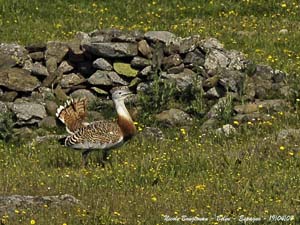
But it also happens that the bird flies away, alerted by its instinct. Yes, this heavy animal takes off without difficulties, with power and elegance, seeming to tear out itself from the thickness of the vegetation to fly above it with slow and deep wing beats.
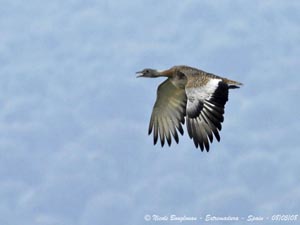

We have to seek them; they usually are rather far from the passage, but not always. Safe by their vegetable hide, they can advance in the middle of a meadow without being seen of whoever. It is a bird which is worth seeing, but when one sees it for the first time, it is moving and exciting… it is great!
The other birds seen in these plains are the Crested Larks and the Corn Buntings. During the nesting period, they have the bill full of green caterpillars and insects. They hover above the tall grasses and dive inside and then, they come out from it empty. That means the nests are on the ground, well hidden in the vegetation. When they leave the nest, the young which are not yet able to fly, disperse into the meadows where the parents still feed them during some days more.

Omnipresent in the dehesa and close to habitations, the Woodchat Shrike perches on telephone wires and fences, or crosses the road while flying. Its conspicuous white wing bars and its reddish crown make it easily recognizable. It is a summer visitor.
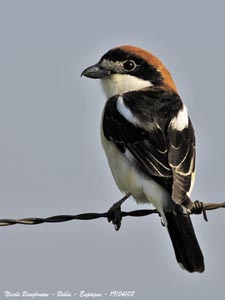
While always advancing into the plains, the discoveries go at a good pace. Red-legged Partridges, Iberian Magpies, Calandra Larks, Red Kites and Black Kites, Common Buzzards, Montagu’s Harriers, Short-toed Snake Eagles, Common Kestrels, Cattle Egrets, European Bee-eaters, all among the wild flowers in full burst of colours, the wealth of avifauna is unbelievable!

It also occurs that in the middle of a large meadow, a strange vision appears in front of our look of surprise: a heron’s nesting place into the fields, gathering here Cattle Egrets and White Storks, but judiciously placed near a large pond! One can find some rather often in the area, as from the moment when a water point is in the vicinity. Cattle Egrets follow the herds, and keep as well cows as sheep!
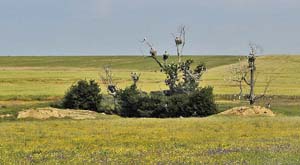

And there, I see them, both side by side as two thieves which have just made the 400 blows! A splendid Monk Vulture and a not less beautiful Eurasian Griffon Vulture, close to each other among the tall grasses, quiet and serene in the morning sun! I cannot believe my eyes. However, I knew that vultures come sometimes in the meadows, but there, I panic a little, make my adjustments in a hurry so that they do not fly away, and the photography session starts. Impassive, they do not move and even they let me change my position in relation to the sun. That is just perfect !
The Monk Vulture appears much taller than the Griffon Vulture, whereas only 20 centimetres separate them. It is massive and a great power emerges from what I see of his silhouette. Its almost black plumage gives it a mysterious expression here, among the green grass. I rather imagined it on rocks overhanging the drop, contrasting against the blue sky, but it is there, at about 150 metres, sitting imposingly in the meadow, under the sun… Truly amazing!

But these magic moments have to come to an end, and our beautiful raptor flies away towards the mountain, its habitat and its refuge. Its impressive wingspan (295 cm) tears carefully it away from the ground, three or four deep and vigorous wing beats are enough for taking-off. The moment is rare. I forget the Griffon Vulture which flies away at the same time, but we will find it later in the park. I am completely speechless (rare too!). It was so beautiful and unexpected!
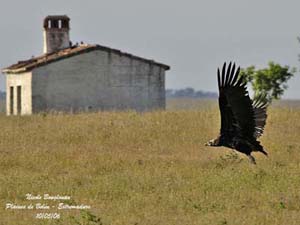
We take again the road, towards the Monfragüe Park and its wonders. Flowers are everywhere, raptors are perched or in flight, Corn Buntings bring food in the bill, Crested Larks are running along the roadside, the scenes reoccur, unchanging, like the beauty of this place.

Declared Natural Park in April 1979, Monfragüe extends on a few 18.000 hectares, and its culminating point is the Peak Casar de Elvira, with 570 metres high. The most famous place of the park is called “El Salto del Gitano” (the Gipsy’s jump). The Tagus flows between two rocky cliffs, its deep blue water contrasting briskly with the ochre colour of the rock.


The road passes just at the edge, on the lowest side. As soon as we stop, we already see a pair of Blue-Rock Thrushes, the female delicately mottled perched in a dead tree, and the male with blue plumage on a rock, always the same, year after year. I do not know if it is the same pair or not. These birds are sedentary in the area and only disperse during winter towards the lower grounds where temperatures are more clement.

But the success of the park is due to its raptors, and more particularly to the Eurasian Griffon Vultures. Very numerous on the cliff which overhangs the river, they circle continuously or remain quietly perched at the edge of the drop, defying the giddy laws! They find enough natural cavities in the face cliff for nesting.
When temperatures are warm, they rise very high in the sky, carried up by the thermals, and may soar during long moments. Early in the morning at the beginning of spring, the fog is such that the opposite cliff is almost invisible. But as soon as the sky is rising, they leap into space, attacking the azure revealed by the patches of fog. Fabulous unceasingly renewed spectacle!

The last observed species during this short stay, is the Black Stork. Some pairs breed every year in the park, coming from Africa where they winter. This year, I saw only one, very high in the sky.
They nest in trees, making a nest with sticks. They settle in the forests, close to the rivers or the marshy zones. Some of them may nest on ledges in cliff faces too. Sometimes, they come into the park, searching for branches for the nest on the steep cliffs. That gives wonderful scenes, where Griffon Vultures and Black Storks meet in the blue sky!

Many other animal species live in the park, from the Otter to the Lynx and the Wildcat. It is a small paradise for animals and flora which benefit from this beautiful climate, combining heat with moisture, and water with the rock. In spring, the Gum Rockroses are in flowers.

Coming back to the plains after this marvellous moment, we find again the fauna and the abundant flowers. The dehesa vibrates under the sun of the half-day and the birds become quiet with the abrupt heat. The flowered fields tremble under the turbulences, the silence reigns. As far as the eye can see, the blue sky, immutable, gives to this landscape an unreal aspect. That is Extremadura!
Text and photographs by Nicole Bouglouan
More photographs:
Sources:
Personal observations made during my different stays in Extremadura.
Wikipedia (Wikipedia, The Free Encyclopedia)
PAJAROS DE ESPANA (JL Beamonte)